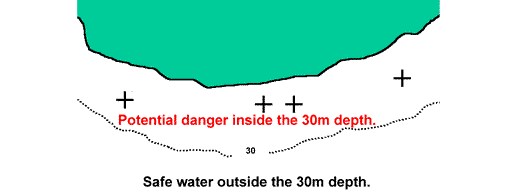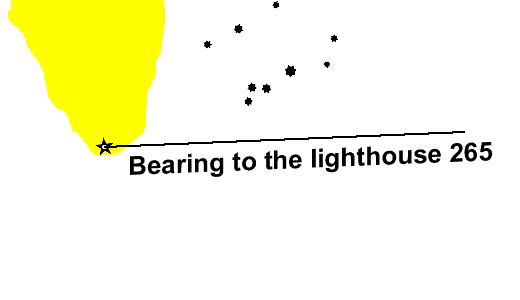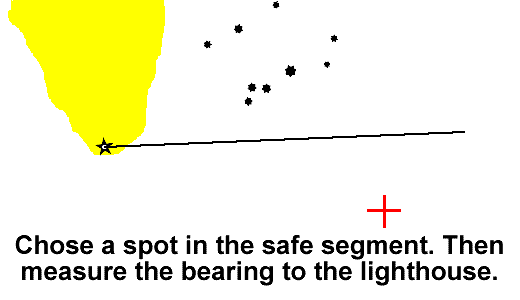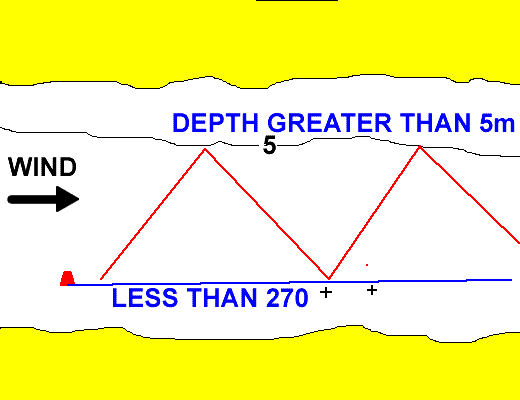When it comes to remaining in safe water, clearing lines are one of the most important techniques that a skipper can learn to apply. Well prepared clearing lines will enable a skipper to enter a region that contains navigational hazards and be confident that the vessel is in no danger.
Because clearing lines can be arranged before the passage commences, they ensure that even if the crew are tired and short handed the boat can be kept safe whilst moving and the skipper should be able to spend the maximum amount of time on deck.
A clearing line divides the chart in to one area that contains hazards and another that is safe.
Clearing depths
One source of clearing lines is the depth. This may be just ensuring that the shallow alarm is set on the echosounder and turning away from the shore if it is activated. At the other end of the scale, a vessel approaching the North Brittany coast may decide that there are no hazards in a depth of greater then 30m, so this becomes the clearing line. Before the days of effective electronic navigation aids; when visibility was poor and the vessel's position uncertain, I would not cross the 30m contour until a clearly identifiable feature was sighted (obviously the height of the tide must be considered).

It is prudent to be in the habit of setting the shallow depth alarm when in coastal waters. Even if it is not being used to negotiate a tricky area of pilotage, it will still act as a warning of last resort if you unexpectedly stray in to a shallow area.
Clearing bearings or transits
Clearing bearings or transits may take a little more preparation than depths, but they can be used when there are point dangers, that is, those for which the changes in depth would give inadequate warning.
For a clearing bearing to work, the navigator must be looking towards a charted object that is clearly identifiable. If a line is drawn from that object so that it passes clear of the area of danger by a suitable margin, it can be clearly seen that the safe water is to one side of the clearing line.

By measuring the bearing of the line and comparing it with the bearing of the object when taken with the handbearing compass, it is easy to decide if the vessel is on the clearing line or either side of it. It is a good idea to place a cross at a spot on the safe side of the clearing line, then imagine that you are at that point. If you then measure the bearing to the lighthouse it will be more or less than the bearing of the clearing line. The chart can then be marked up with the clearing line being more than 265 degrees.

If this approach is not followed, it is very easy to have the more than/less than element wrong.
In the above example, provided that the bearing to the lighthouse is more than 265 degrees, the vessel is in safe water. This has nothing to do with the heading of the vessel at that time. Working out the course that should be steered is a different problem.
Clearing lines when going to windward
One aspect of pilotage and navigation that can be difficult for novice skippers to understand is how to sail a yacht to windward and not get lost.
Although it is possible to construct Estimated Positions from the log book data, this requires a great deal of skill and practice to do for real. The time taken could be much better used for other tasks when in confined waters.
The best means of piloting upwind in confined waters is to create clearing lines on either side of the proposed route. The vessel is then kept between these lines and by careful choice of where to tack, the yacht's position can be confirmed occasionally by passing close to any available navigation marks.

In this example, the yacht tacks when the depth decreases to 5m (allowing for the tidal height) on the north west bound leg, then tacks when the bearing to the red buoy increases to 270 degrees. This last bearing clears the rocks. The vessel's position is only known for certain when it reaches the buoy.
A common question from people who have just completed a classroom theory course is, "How do I know what is the correct course to steer?" The answer is obvious when you have sailed enough, it is the best course you can make to windward!
Sailtrain.co.uk is free to use, but if you feel you would like to contribute to the running and development costs you can donate via Paypal:
Additional Resources:

